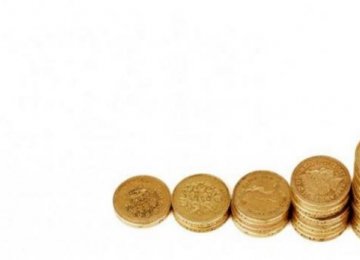Data released by the Central Bank of Iran for the month ending April 20 shows that banks faced a huge challenge in the past year in holding on to their deposits. The downward spiral began well before the Money and Credit Council reduced the cap on deposit rates to 20% in March.
Deposits grew by 18.9% year-on-year which was the lowest in five years. The report says bank deposits stood at 8.3quardliion rials ($287 billion at the official exchange rate) at the end of the said period (first month of the Iranian calendar), a monthly growth of 1.7%, down from a 2.4% a year ago.
The haircut on bank deposits is rather counterintuitive given the bearish trend in most other markets. Prolonged recession in the key housing sector and investors’ lukewarm interest in the gold and forex markets as well as slumping stocks had made a rush of cash to banks almost inevitable.
Interest rate cut by the CBI earlier this year probably factored in the topsy-turvy. Lender’s high deposit rates in the past had turned them into safe havens for risk-free investment. But as rumors about further rate cuts spread, banks started losing their long-held appeal as the top choice for investment and income from deposit rates, especially for retirees and mid-income households.
Official figures indicate, however, that private banks and credit institutions still have the upper hand in luring depositors. Commercial banks have engaged in a tug-of-war with uncertified financial institutions over interest rates, with the former desperate in trying to attract depositors, especially those with big money.
Uncertified institutions of various stripes account for almost a quarter of all liquidity, the central bank says, offering tough competition to the conventional lenders. They fall outside of central bank supervision and, as such, do not have to meet a 15% reserve ratio and offer far more tempting interest rates, sometimes as high as 30%.
Pain of NPLs
The mushrooming growth of such institutions during the two tenures of former president Mahmoud Ahmadinejad , prompted monetary officials to call for their dissolution. But the acrimonious closing of Mizan Credit and Financial Institution compelled officials to think otherwise, offering the quasi-banks a one-year respite to get in line and register with the regulator.
Declining bank deposits are also indicative of lenders’ falling revenues as they grapple with non-performing loans estimated at $60 billion as well as colossal government borrowing over the previous years.
The same report indicates banks’ reserve requirement ratio saw a slight improvement: in the month ending April 20 the ratio was 11.3% from roughly 10.7% a year ago.
Banks have been routinely castigated by policymakers for falling short on both capital adequacy and reserve requirement, which increases their vulnerability as commercial lenders prepare to renew cooperation with foreign banks as sanctions begin to fade.
Although banks’ loan-to-deposit ratio is still in risky territory at 91.3%--the global standard being 85%--, nevertheless it continued a decline from 113% two years ago when banks used to splurge loans on selected sectors of the economy.
According to a Moody’s report last week, the lifting of nuclear-related trade and financial sanctions on Iran would be credit positive for Iranian banks. The report says increased trade and investment could boost growth in Iran’s banking sector and support asset quality of domestic banks, although such improvements would depend on the strengthening of banks’ capital levels and the implementation of structural reforms.






